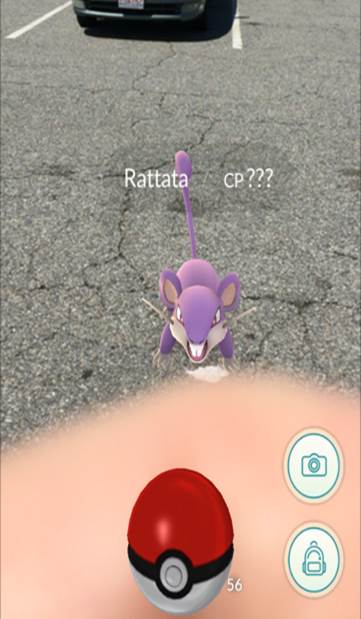July 12, 2016
 By Lynette Owens
By Lynette Owens
Last week, Nintendo launched Pokémon Go, a mobile gaming app based on its popular game franchise of the same name. The app is free and is unique in that it requires players to move around in the real world in order to advance in the game and get rewards. Players create their own avatar which is animated, as are the characters in the game, but they are overlaid onto real images coming through the camera of the player’s mobile device. It’s the first widely available and, as early reports have shown, wildly popular app that take advantage of augmented reality.
I signed up and tested it within the confines of my home and backyard, my 9-year old looking over my shoulder eager to try too. The novelty of looking through your phone camera and then suddenly seeing a character sitting on your own couch is definitely a cool experience. I had to throw Poké balls at these characters in order to continue on in the game. In [my] reality I actually preferred these creatures not disappear because I captured them.
I had hoped to simply move around within a reasonable area within and near my home, but after 20 minutes of walking around – avoiding table legs and door jams – I realized the game is very limited if your geographic boundaries were limited too. Eventually, I just got bored and stopped playing.
The news circuit has latched onto this craze and for the most part has focused on stories of people’s predictable lemming-like behavior, Nintendo’s stock price rise, and the dangers this new type of game presents (leading you to unsafe places, tracking a lot of personal data as it requires your geo-location, etc.).
I believe it is best to try out the app and judge for yourself. I also highly recommend you do this before or WITH your child before letting them go search for imaginary creatures all over town (and possibly further). As fun and simple as it may seem, there are definitely risks to be aware of.
Here are 6 things in particular to keep in mind:
- The app is called Pokémon Go and it is free. There are a lot of comments in the user agreement about in-app purchases, but I did not use the app long enough to get to that point of needing or wanting to buy anything. That said, you can make sure your child does not rack up tons of real-world charges to your credit card bill by turning off the in-app purchasing feature, requiring a password for the app to charge against your credit card, or using gift cards for app purchases rather than a credit card.
- It is designed to be used on a mobile phone. Don’t use it with your iPad, Kindle Fire, or something that you can’t easily hold with one hand.
- There is no age limit.** However, you need a Google account or Pokémon Trainer Account to sign in to use it. Google already requires you to be 13+ to have a Google account. Nintendo allows kids under 13 to have a Pokémon Trainer Account, but signing up for one requires parental consent.
- **But, the app makers state it is ideally for age 9+. I don’t think many 9 year olds should just go off wandering around town to play this game by themselves, just as I wouldn’t recommend they go off anywhere without adult supervision. I launched the app again after I left my house, and in the middle of a parking lot I discovered there were several more characters for me to capture. Staring at my phone and swiping towards an imaginary creature is not the safest thing to do there.
- You must allow the app to use your geo-location in order for it to work. Be aware of this and the privacy you may be giving up to the app as a result. You are basically signaling your physical location at all times and how long you spend in those places.
- The user agreement has many statements about safety, but there isn’t a way to report safety issues. The terms of use encourage players to use the app with care (i.e., watch where you’re going!). It also states that people should not break any laws while using it (i.e., don’t rob people, don’t break into people’s private property, etc.) What I didn’t see in those terms or anywhere in the game is a way to report concerns. This is something I think will be demanded and should be designed into the game in the near future.
In the end, I got a little bored of the app. I think it could be great fun if I had the time or energy to run around town looking for Pokémon.
That said, the idea of augmented reality has its merits; many applications of this technology are yet to be. Imagine walking into a big box store, wondering where to find a certain item? Don’t need to ask anyone, just hold up your camera and arrows will point you the way AND deliver a coupon to you by tapping on the image of the item once you find it. The advertising potential for this technology is pretty huge (maybe Starbuck’s has something waiting in the wings?).
The Pokémon Go game is an incredible leap forward for augmented reality, and a new use of mobile devices. For decades, Pokémon has been popular with kids, including the good old fashioned Pokémon trading cards. But as an app to get kids up off the couch and play outside, I think it is somewhat flawed and has a lot of inherent risk. If Nintendo made it so younger kids could find lots of characters within the confines of their home or a single park or playground, I would feel much better about my kids using it.
But as a replacement for sedentary gaming? Not really. Just have your kids put the phone down and go chase a real soccer ball or shooting star instead.
Lynette Owens is the Founder and Global Director of Trend Micro’s Internet Safety for Kids and Families program. With 20+ years in the tech industry, Lynette speaks and blogs regularly on how to help kids become great digital citizens. She works with communities and 1:1 school districts across the U.S. and around the world to support digital literacy and citizenship education. She is a board member of the National Association of Media Literacy Education and SPARK Kindness, and serves on the advisory boards of INHOPE and U.S. Safer Internet Day.
Follow her on Twitter @lynettetowens
Lynette Owens is Vice President of Consumer Education & Marketing at Trend Micro and Founder of the company's signature Internet Safety for Kids and Families program. With 30+ years in the tech industry, Lynette oversees global initiatives to help deliver the technology tools and education that people of all ages need to keep themselves and their families safe online. She serves on the advisory boards of the Identity Theft Resource Center's Alliance for Identity Resilience, the Global Anti-Scam Alliance, and INHOPE.
